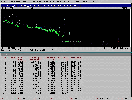
Purpose:
- Qualitative and quantitative analysis of gamma spectra
- Control over the analyzer and spectrum accumulation parameters
- Energy, half-width, and efficiency calibration
- Calculation of activities, errors and MDA (minimum detectable activity)
- User’s graphical interface employing windows, a menu, and a mouse
Description:
The program carries out a fast qualitative and quantitative analysis of gamma spectra in a user-convenient interactive mode with communication through the menu and windows. Both the keyboard and the mouse can be used for the work.
The spectrum to process can be read from the ADC or disc. A wide set of scaling functions is available for viewing the spectrum. Information on the sample parameters can be stored for each spectrum; this information will be saved together with the spectrum as the latter is recorded to the disc.
The program includes procedures for calibration of the system. The energy and half-width calibrations are approximated by polynomials up to degree 3. The calibration points can be specified manually, by the marker’s position, or (for half-width calibration) automatically from the latest result of the spectrum analysis. A polynomial up to degree 5 can taken for the efficiency calibration. A special feature of the program is its ability to carry out calibration on the basis of a few different spectra, the calibration points derived from each previous spectrum being saved and used in the calculation together with new ones. The quality of the calibration can be visually assessed from the plotted curve.
The automatic peak search algorithm finds peaks whose statistical significance exceeds the threshold set by the user. The algorithm rejects Compton and spurious peaks. The user can mark or remove peaks manually. In the calculation of peak areas it is possible to subtract areas of background peaks found during the processing of the background spectrum. The energy calibration and the library of nuclides are used to identify nuclides. The identification criteria may be set by the user. The activities of the nuclides are calculated by the least squares method with allowance for mutual contributions from various nuclides to the unresolved peaks. The activity and MDA measurement errors are calculated for each radionuclide. The activities can be normalized to the weight or volume of the sample. The units of activity are set by the user. The program makes correction for the decay during the time for which the sample was left to stand.
Based on the results of the analysis the program generates a report, which includes a table of the peaks found, a table of the identified lines, and a table of nuclide activities. The form of the tables and the report may be specified by the user. The report can be displayed, printed, or stored as a file. It is also possible to print a plot of the spectrum with identifications of the peaks found.
The program allows the library of nuclides to be created, loaded from the disc, stored on the disc, and edited in a user-convenient interactive mode.
The program requires MS-DOS, 640 KB RAM, a floppy or hard disc drive, a VGA graphical adapter.
|
